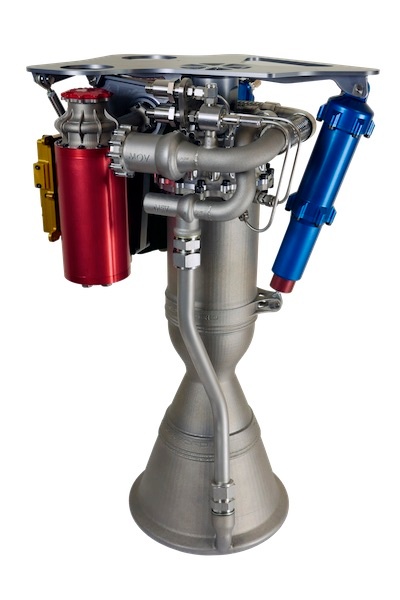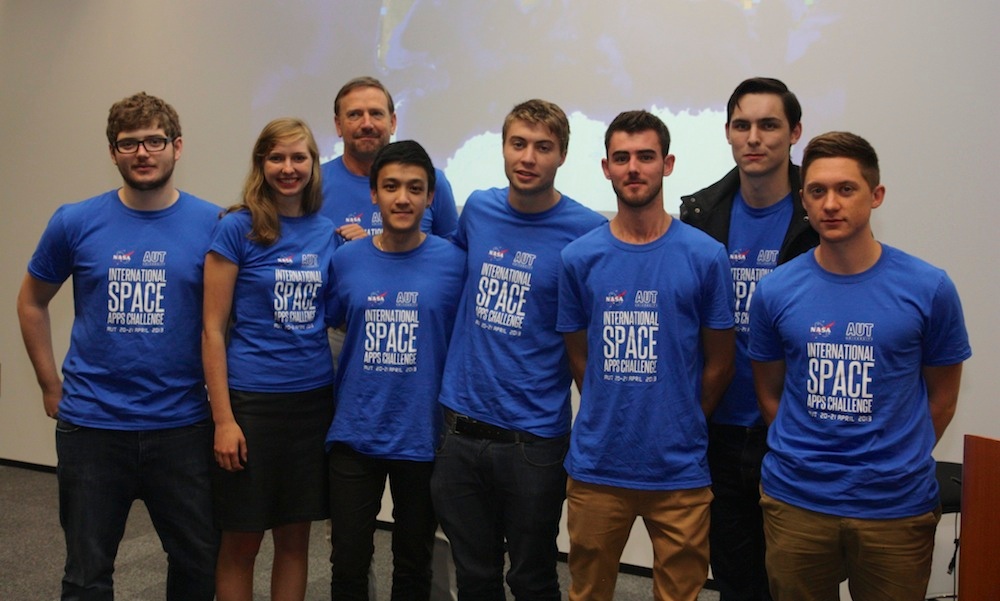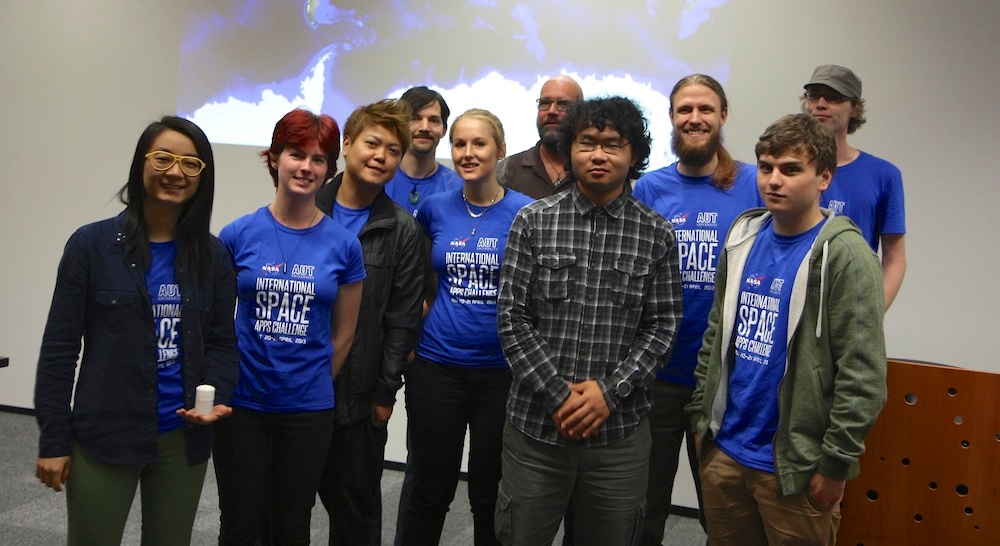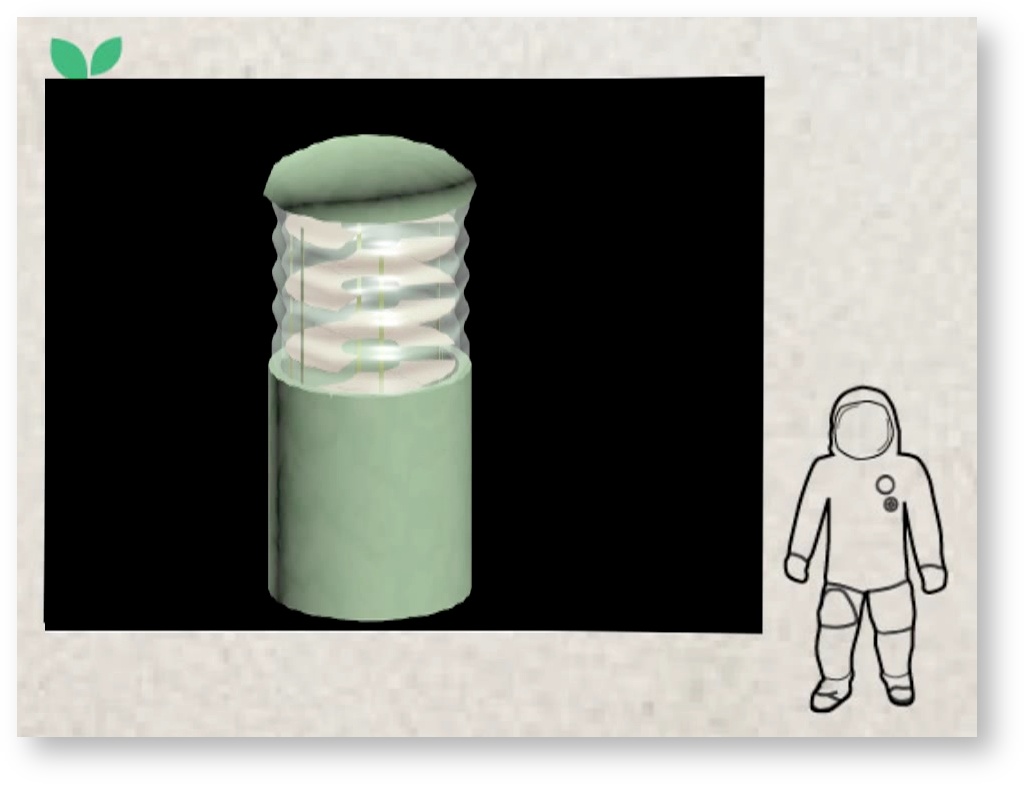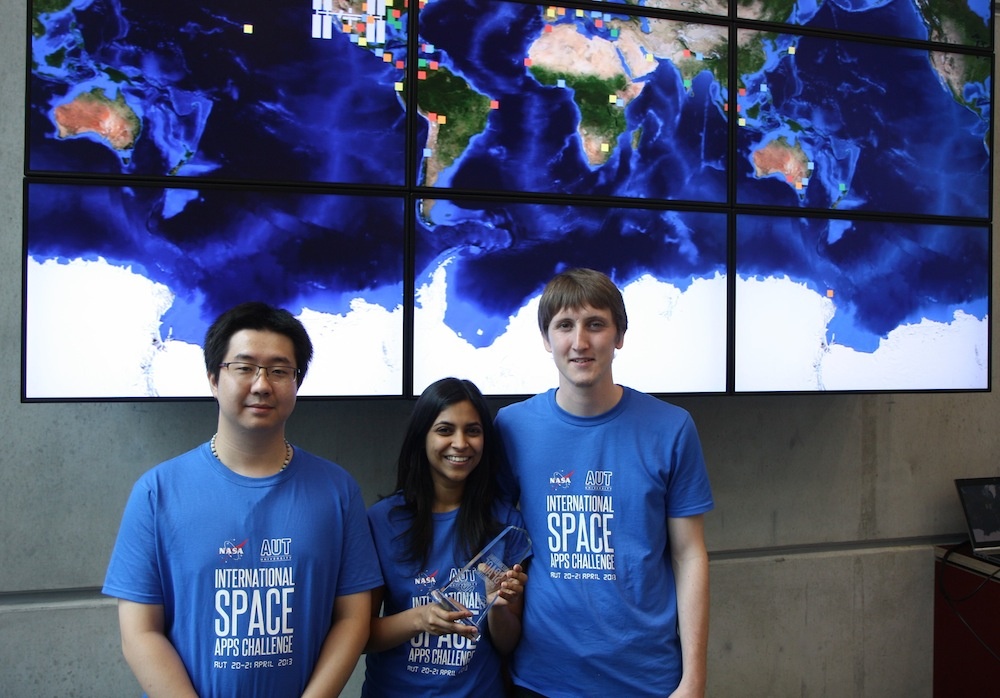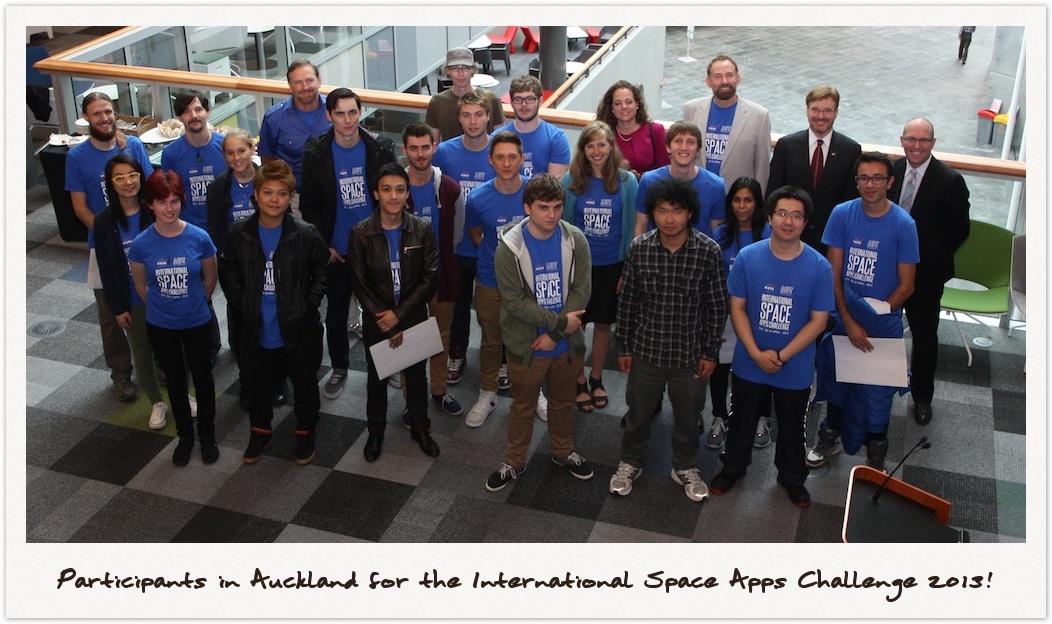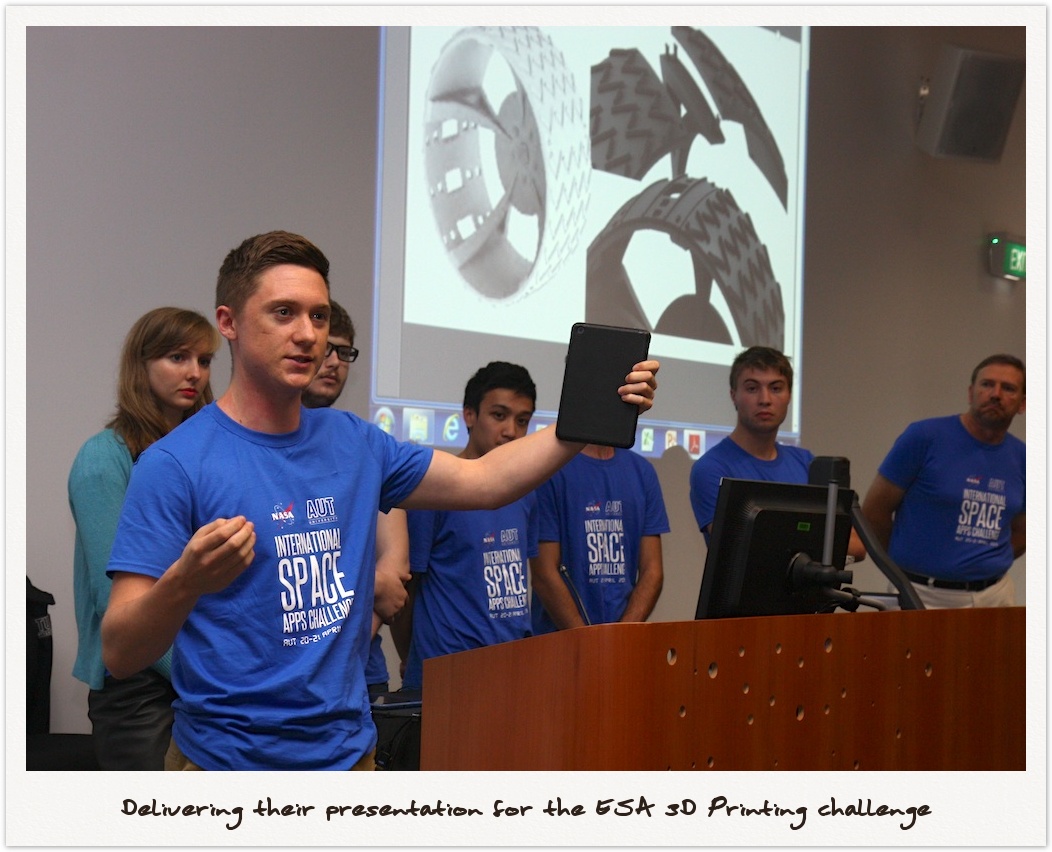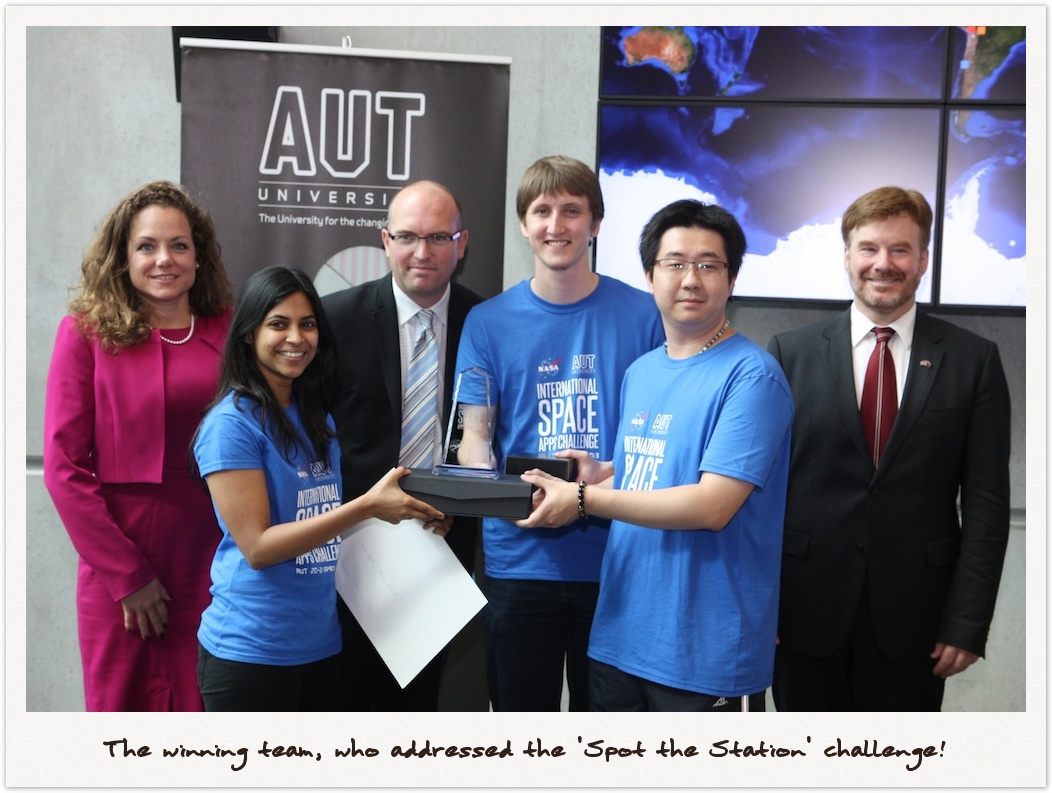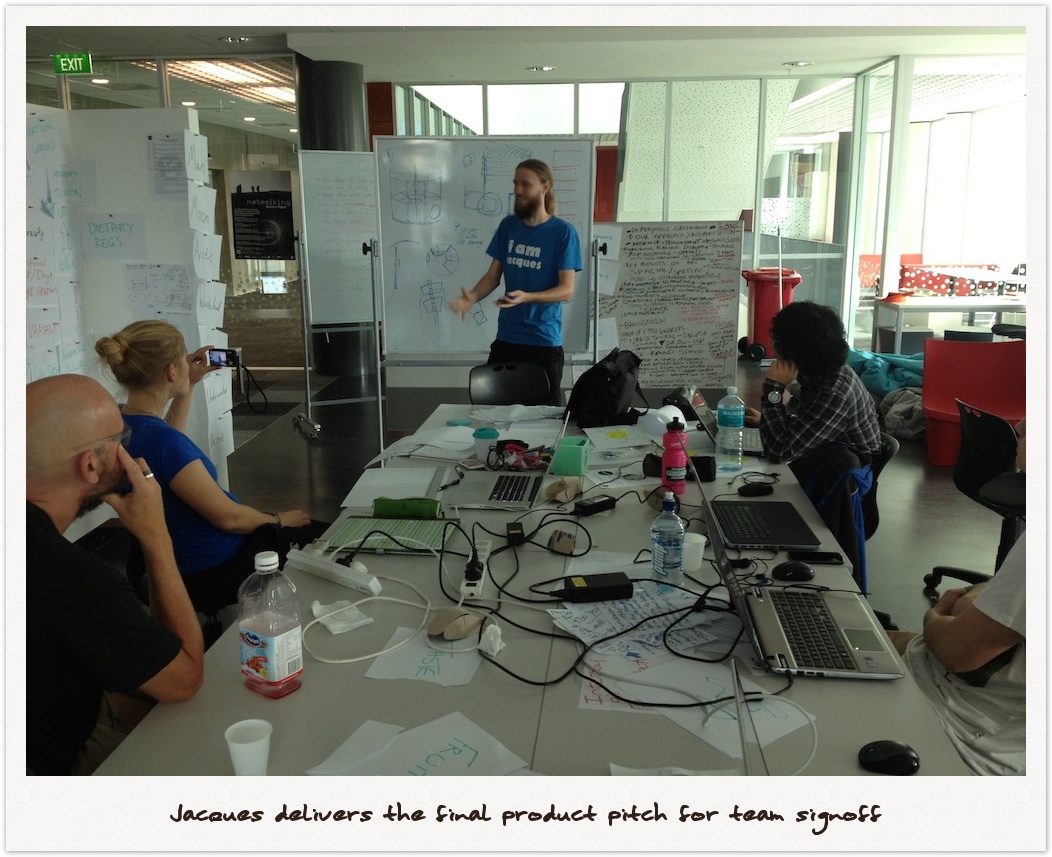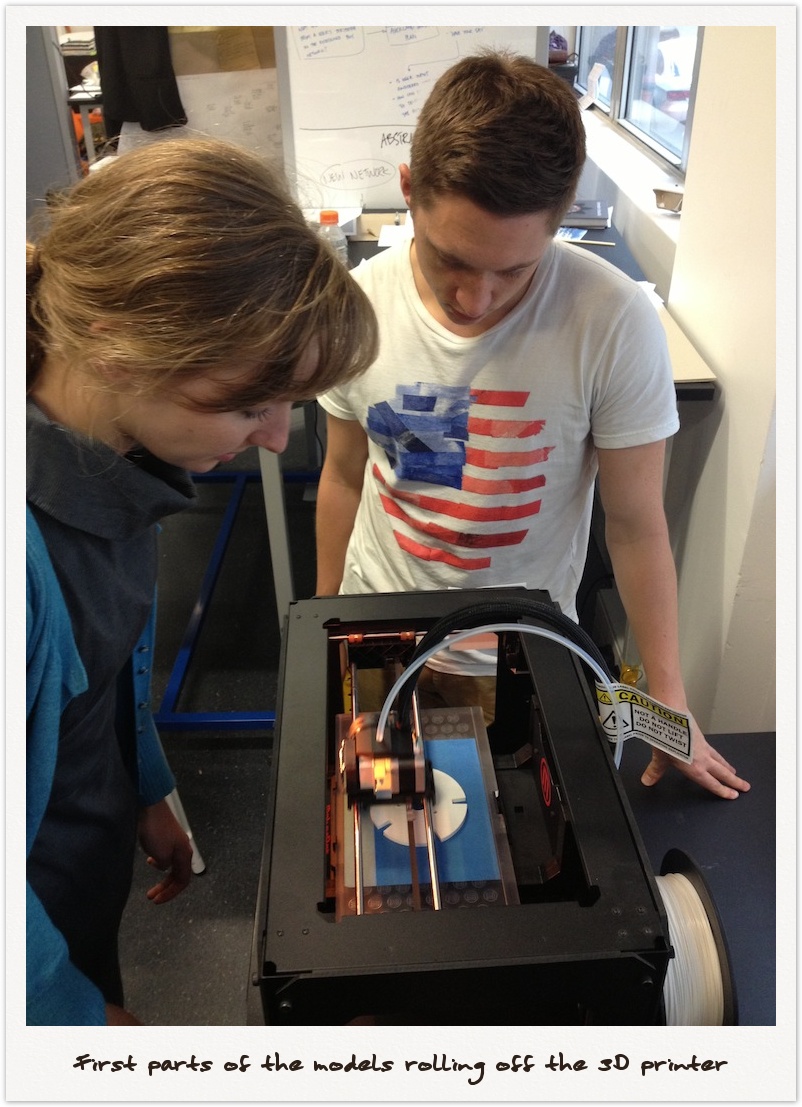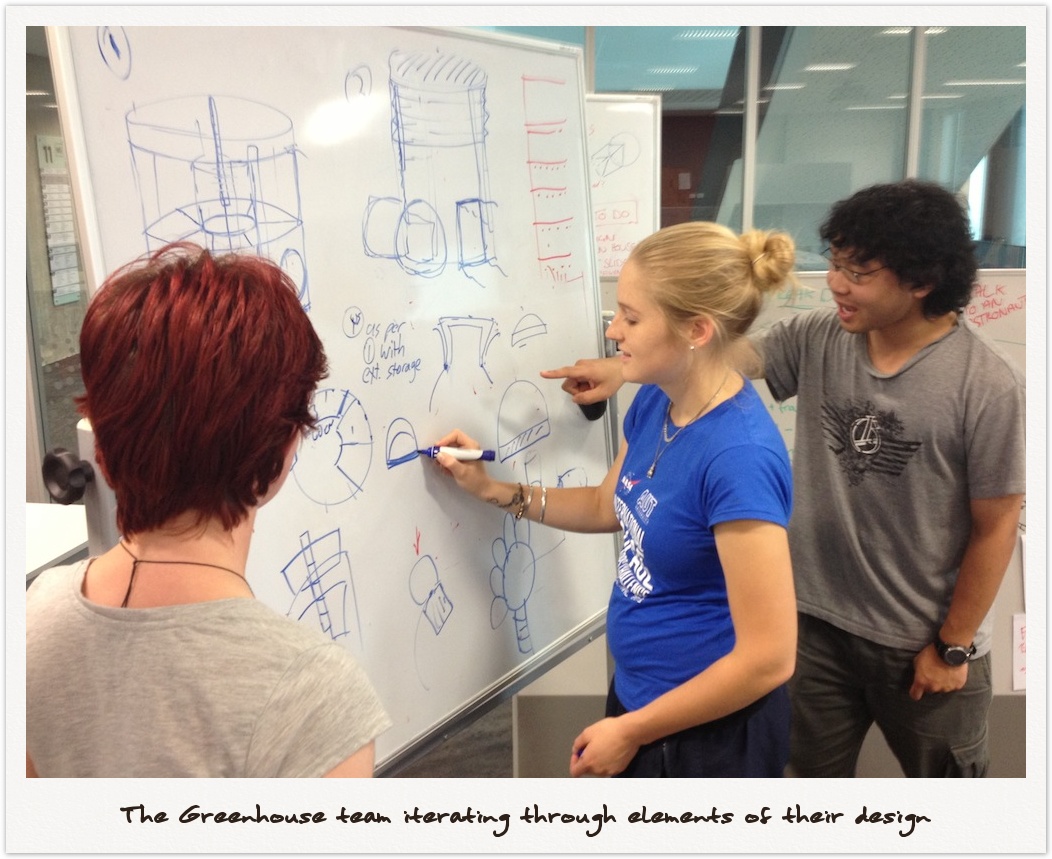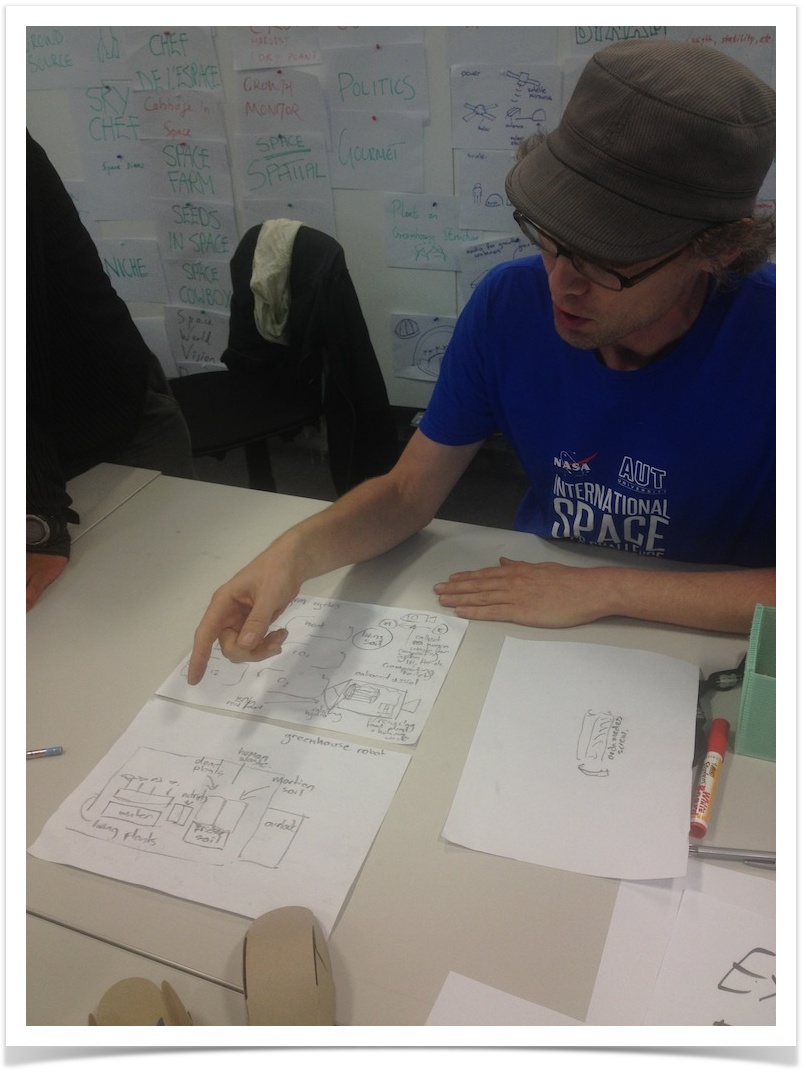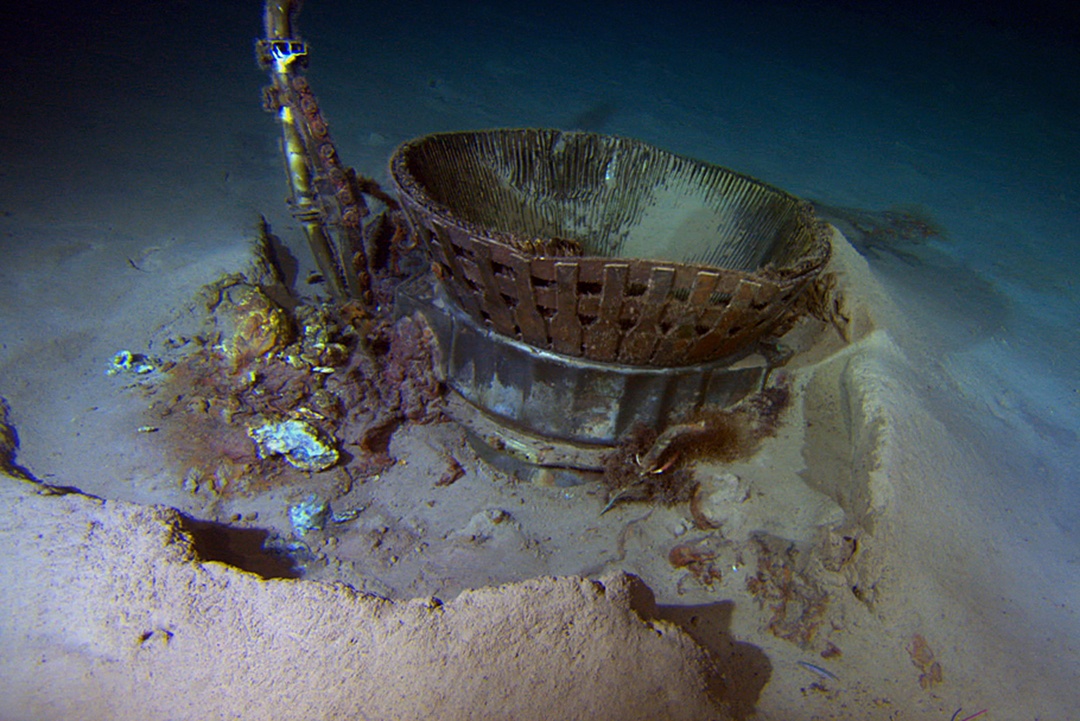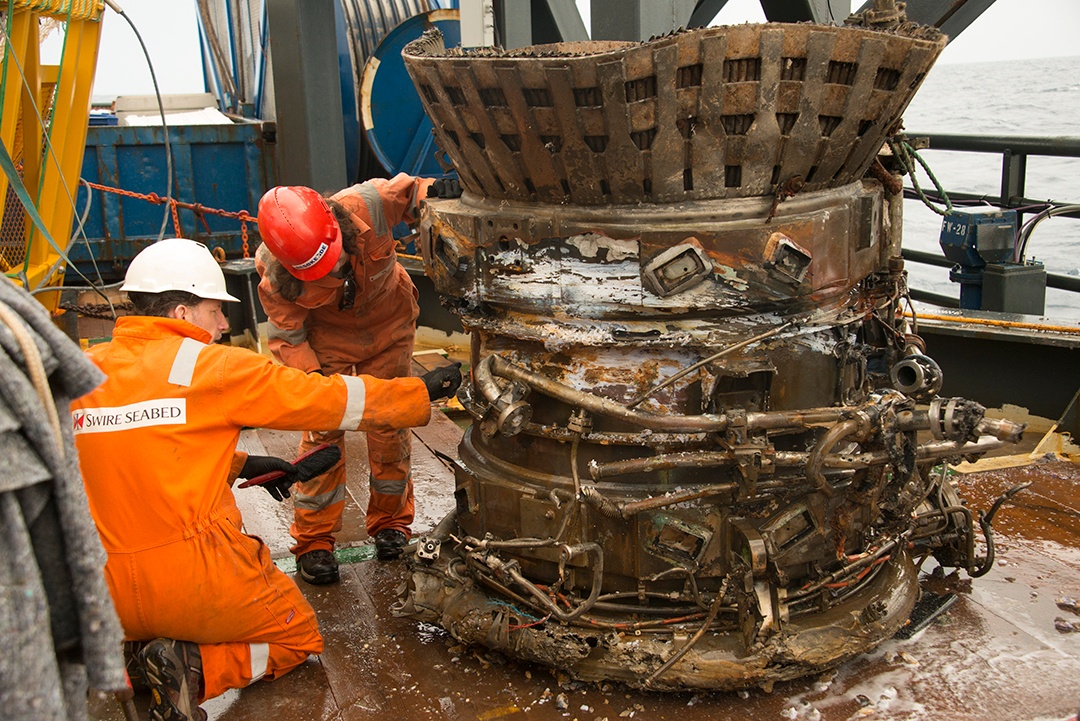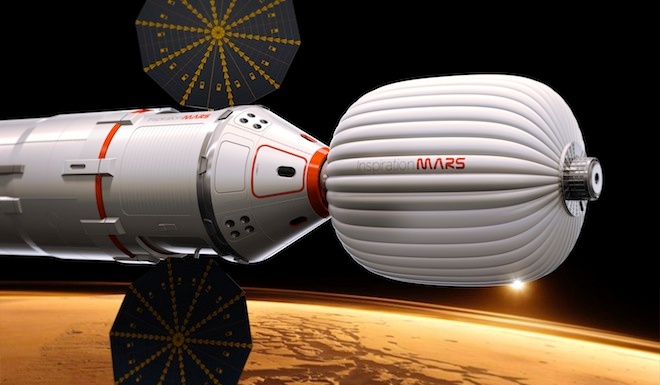By Mark Mackay and Iain Finer
Peter Beck, CEO of Rocket Lab stands with an early test article of the Electron rocket
Electric Rutherford Engine
According to their press release:
“Unlike traditional propulsion cycles based on complex and expensive gas generators, the 4,600 lbf Rutherford adopts an entirely new electric propulsion cycle, making use of high-performance brushless DC electric motors and lithium polymer batteries to drive its turbopumps.”
So how does switching to electric turbopumps help?
Firstly, this must be far simpler to manage than all the additional plumbing, control systems, and moving parts that come with traditional systems. Switching to an electric motor that turns on with the flick of a switch seems like a no-brainer. And with nine engines in its tail, this will substantially simplify the intricate web of cables and hoses.
Electric pumps should also provide a great deal of control over how the propellant is injected into the engine. Electron utilises liquid oxygen and rocket-grade kerosene as propellants, and like most engines - the mixture needs to be delicately controlled to match various power levels. We would imagine that it is possible to shut down and then restart the engine mid-flight. Electric pumps may also provide improved dynamic control over fuel flow rates, allowing for fine-grained tuning of the mixture and even greater efficiency and throttle-range.
| Rocket Lab's new Rutherford engine, powered by two electric turbopumps (one visible, in red). Pneumatic actuators (blue) allow the engine to be steered. | Compared with SpaceX's Merlin 1c engine - Rocket lab doesn't need the turbine exhaust and should require far less plumbing. (Note: the two engines are vastly different sizes in real life)
|
A big question is whether the electric turbopump will save weight. Batteries are heavy, but the turbopump itself would likely be lighter than its gas-fed equivalent, and all of the rocket’s propellant would be used to get the vehicle to orbit (not spin pumps). We need some more specifications from Rocket Lab to answer this question, but we’d gamble that it's more efficient, or the simplicity trade-off was worth it.
Moving away from gas-turbines was also likely driven by size constraints. SpaceX’s Falcon 9 rocket is 3.66m in diameter, whereas Electron is only 1m. This makes the engine no larger than the average kitchen rubbish bin.
KiwiSpace unfortunately wasn't present at the Space Symposium, but other media coverage has revealed additional information and confirmed some of our analysis:
- The battery-powered pump, (Peter Beck) said, can be easily changed with software, making it far easier to modify. “It takes a really complex thermodynamic problem and turns it into software that’s infinitely tweakable,” (Source)
– This supports our suggestion that Rocket Lab will have finer-grained control over the propellant mix and make it easier to optimise the engine performance. - Additive manufacturing allows the company to build a rocket engine in three days, versus a month for traditional approaches. (Source)
– We would also imagine that if the process becomes optimised so you just hit "print", then you can horizontally scale a large part of the production just by having multiple 3D printers. Certainly a 3-day turnaround on building a rocket engine is impressive. - The approach, says CEO Peter Beck, eliminates the complex valves and other plumbing required to use hot gas to turn turbomachinery, boosting efficiency from 50% for a typical gas generator cycle to 95%. (Source)
- Each Rutherford engine has two electric motors the size of a soda can, Beck says, one for each propellant. The small motors generate 50 hp while spinning at 40,000 rpm, “not a trivial problem,” (Peter Beck) says. (Source)
What’s in a name?
The announcement also puts greater heritage in Rocket Lab’s choice of nomenclature for their rocket systems. Founder Peter Beck has previously announced that the engines were named after New Zealand scientist Ernest Rutherford. The choice to name the vehicle “Electron” was perhaps dismissively thought to relate to the scientist’s nuclear physics work, but may be more to do with the battery-powered rockets within.
Printing your own Rocket Engine
Rocket Lab is following a similar approach to most newspace companies and is adopting 3D printing for as many systems as possible:
“Rutherford is the first oxygen/hydrocarbon engine to use 3D printing for all primary components including its engine chamber, injector, pumps and main propellant valves. Using this process, Rocket Lab’s engineers have created complex, yet lightweight, structures previously unattainable through traditional techniques, reducing the build time from months to days and increasing affordability.”
3D-printed rocket components and engines have been successfully tested but if Rocket Lab achieves their target to launch by the end of 2015, they may be the first to achieve orbit using one.
- In another effort to increase efficiency and hold down cost, Rocket Lab is building the regeneratively cooled engine using three-dimensional, additive-manufacturing techniques that include laser and electron-beam sintering, with Inconel and titanium powder as the feed stock. (Source)
Payload Integration
One of the more “why didn’t I think of that” announcements for both authors related to how they plan to get the satellites loaded into the rockets:
“Electron’s upper stage is designed with the capability to disconnect the payload integration from the main booster assembly. Sealed integrated payloads can then be transported back to Rocket Lab where integration with the main booster can occur in a matter of hours. This approach eliminates the risk of cascading delays and allows customers to regain control of the integration process, using their own preferred facilities and personnel.”
It’s important to remember that Rocket Lab are targeting weekly launches of Electron. Traditionally the launch vehicle operator take a large role in integrating their customer’s satellite into their vehicle. If there are problems, this can be very time-consuming and costly for both parties to resolve. And if you’re trying to manage 52 satellites each year, that’s a lot of logistics to coordinate.
Rocket Lab elegantly solves this by making launch integration the customer’s responsibility. They simply ship (sell?) them the top of the rocket, let them spend as much time as they want getting their satellite to fit and plug in correctly to the module - and then they ship it back to Rocket Lab to launch. When it arrives, it’s given a quick check-out, placed on top, you attach four bolts, connect a few umbilical cables and drive it out to the launch pad. Of course we’re overstating the simplicity, but clearly moving the complicated phase off-site will save Rocket Lab a lot of headache.
And there are other potential benefits too. What do you do if you’re launching each week, and your customer hasn’t dropped their satellite off yet? Simply grab the next integrated satellite from your holding area and launch them instead! Or what if you notice a problem with your rocket while you’re running your pre-flight checks on the launch pad? You simply swap out the rocket base with another one, and continue your countdown.
There are some interesting questions from a legal standpoint. If you’ve made the satellite operator do their own payload integration, and you’ve launched and delivered the rocket to the right orbit -- then presumably it’s their fault if something is wrong with the satellite. But what if the payload fairing fails to separate? The customer integrated the upper module, but it was Rocket Lab’s hardware…
Another interesting angle is sensitive payloads and dealing with countries/organisations that don’t meet normal security requirements for dealing with rocket hardware. Potentially the US government for example could ship Rocket Lab a sealed upper-stage, with “do not open” instructions. And customers without security clearance can still hand-over their integrated satellite at the door to the building, and just not be allowed to see inside.
- “We can integrate them within literally minutes,” he said. “It’s four bolts and we have a payload completely integrated onto the launch vehicle.” (Source)
— This certainly is an exponential leap over the timelines for other rocket integrations.
--
Overall, today’s announcements by Rocket Lab are very exciting and bode well for them delivering on their planned price-point and rapid launch schedule. All this innovation needs to be flight-tested of course, but in many ways their changes simplify the rocket and reduce risks.
We hope there are more tidbits revealed at the NSS conference this week. And in the coming months we should learn where in New Zealand they’ll be launching from -- and most importantly, when that magical first launch attempt will be.
Through discussion with media at NSS, Peter Beck/Rocket Lab also provided some other useful tidbits:
- There is little aviation and marine traffic that the company would have to work around, and New Zealand’s regulatory system is simple. “For a $400 New Zealand government fee, we can go to orbit,” (Peter Beck) said. (Source)
— This low cost is certainly a great advantage to Rocket Lab and New Zealand for space-related activities. No doubt New Zealand will develop additional processes and legislation around rocket launch activities, but hopefully they do this in a measured way that support development of industry. Australia unfortunately front-loaded legislation in response to a commercial venture that failed to proceed, and thus launching from Australia carries a very high cost. - Rocket Lab currently has about 50 employees, most of whom work in New Zealand. However, Beck says he considers the company an American one, with its headquarters in Los Angeles and plans to obtain a commercial launch license from the U.S. Federal Aviation Administration. “The vehicle flies a U.S. flag. It’s a U.S. launch vehicle,” (Peter Beck) said. (Source)
— While no doubt fuelled by nationalistic sentiment, we can't help but feel disappointed by this statement. Perhaps it has been said to support the context of the customers they're trying to target at the Space Symposium (dominated by US companies and government), but it's a shame that they aren't embracing their NZ roots. From past reports Rocket Lab is looking to launch from Cape Canaveral at some point in the future, which would give greatly simply approval processes if they are launching US Government payloads. They've also secured several rounds of funding from US-based investors. It will be interesting to see if the rockets launching from New Zealand bear a US-flag though - as this would make the United States one of the "launching states" (as defined by space law) - and undoubtedly introduce a substantial paperwork burden. - Beck says the company has about 30 “commitments” from customers. (Source)
| Electron Fast Facts |
|---|
|
On Sunday 6 April KiwiSpace was present at the Science Street Fair, held at MOTAT in Auckland. This event brought together scientists and technology groups from around New Zealand, for a day of hands-on activities for the general public.
This was our first attempt at doing an expo-style stand: most of our activities to-date have been done through schools, in a more controlled learning environment. So the challenge was to find something engaging yet still educational, that could be digested in a very short time, and would keep a crowd entertained.
JAXA-Inspired
We modelled our activity off a session that JAXA presented at our recent SpaceEd Workshop. Professor Kubota from their Space Education Center, led the teachers present through a brief explanation of the challenges of controlling interplanetary rovers over great distances - then set them lose with a simulation of the real thing. They had a remote-controlled car, and put a small camera on top and using some software that came with the camera, they could add a small delay. Teachers then had a chance to drive the rover around, while looking at the video feed. But to add an extra challenge into the mix, and to simulate in-part the transmission delay - the person seeing the video couldn't actually drive the rover, but rather had to relay instructions to another person who had the remote control. They held up signs for "forward", "turn left", etc. Together they needed to navigate a small obstacle course and get to the target marker. Needless to say, a lot of fun and hilarity ensued...
Adaptation to an Expo-environment
Our first challenge, was that we couldn't find the same camera in NZ â and that we needed a solution that lasted for a full 8 hours... Quite a challenge for a small battery powered wifi camera, etc. After much searching around, our solution was to use an iPhone with an extended battery sleeve â and that gave us around 10 hours of operation. We couldn't find any time-delay software on the App Store, so ended up writing our own solution â using just simple Javascript & HTML. It all worked a treat, and gave us great control over the time-delay.
Sample Code: We've decided to open-source the code we developed for the web-based time-delay video feed.
We won't proclaim that it's the highest quality code, but it worked for our purposes - and so hopefully others will find it useful:
- Sample Website: http://kiwispace.github.io/RoverApp/
- This should work offline if you open the page up in a browser before you disconnect from the network.
It is configured to cache all the web resources using HTML5 offline caching.- Source Code & Documentation: https://github.com/kiwispace/RoverApp
Rover, by MindKits Invent
We were extremely fortunate to have the support of Mindkits Invent, who provided one of their BrainBoard Rovers. This cool little bluetooth-controlled rover was an awesome little robot, with great freedom of movement – that really paralleled the rovers on Mars.
We combined the rover and time-delay controls with some rotating slides showing a series of short video clips about the Spirit/Opportunity & Curiosity rovers, as well as an explanation about the time-delays for communication between the various planets. This played silently while the activity was underway, and our helpful volunteers answered any questions from the attendees.
A big hit!
For our first attempt at this style of activity, I think we did really well. We had a constant crowd of onlookers and people queuing to have a go with the rovers. A good number of people signed up to our newsletter to get more information on our future events, and we got lots of great comments and questions from people.
We weren't sure what sort of crowd to expect (there was about 1200 in total through the gates, of which i'd say about 1000 came through our room!) â but it turned out to be a slightly younger audience than perhaps our target market. These younger children had a little more difficulty controlling and working as a team, but nevertheless the activity engaged them (even if they did peek often to see how they were doing!). And their parents got quite involved too and learned a lot too.
To close, I'd like to say a big thanks to a few people:
- Marko Alach -€“ our lead for this project, who worked tirelessly in the weeks leading up to the event, and made this possible.
- MindKits Invent -€“ and Brody Radford, for lending us the rover and providing their assistance on the day.
- Janice Mackay -€“ who volunteered for several hours on the Sunday to support this activity.
- JAXA Space Education Center - for their support this past year, especially with SpaceEd – for which we otherwise would never have considered undertaking such an activity.
- Prof. Kubota from JAXA - whose presentation at SpaceEd was the inspiration for this.
Mark Mackay
Executive Director,
KiwiSpace Foundation.
Three-to-four years ago, Kiwispace was just a glimmer of an idea – spawned from the thought that there should be some organisation out there that encouraged students to pursue space-related careers and activities. KiwiSpace Foundation was born several just under a year later, and the rest they say, is history.
Well, sort-of. Life isn't easy for new volunteer-led organisations â and it takes a lot of hard work and perseverance. We've got a core team of outstanding individuals who've been there thick-and-thin, and always put their all into KiwiSpace. My sincerest thanks to them.
But of course, after three years - it's a good time to take a little bit of a retrospective and evaluate what's working, what's not â and make some changes.
Big changes for education at KiwiSpace
One major item covered at the recent AGM, was a discussion on our strategic direction, and in particular some ideas for our education strategy.
If you're a teacher or keen to get involved in our education programmes, then we encourage you to view the full presentation. But the key points were:
- A change in focus from in-classroom programs to direct-to-student activities.
- Creation of an Online Space School, possibly with a gamified, micro-learning approach.
- Regular hands-on learning and educational events throughout the country, designed for students participating in the program.
- Volunteer Friendly: Easy ways to get involved, and an increased focus on training and getting satisfying results.
- Education opportunities bulletin, for teachers.
Volunteer-Friendly KiwiSpace
It's early days â but we're all quite excited about the possibilities this new direction offers. A large part of it is making KiwiSpace more volunteer-friendly.
In the past, if you'd heard about KiwiSpace, got in touch and said 'how can I help?' -- we didn't really have a good answer for you. We tended to do a few medium/large-sized projects (for us) throughout the year, and they required a level of commitment from volunteers that was a bit daunting right out the gate. We also didn't have a structure in place to bring them up to speed, and the 'reward' from helping out with a project was often several months off. All of this wasn't good for our core team, who felt a little overworked – and found it tough to find new volunteers while also trying to keep existing our projects on track.
So with our change in education strategy, our goal is to do much smaller events and activities, more frequently – and with more structure. So if you're big on Mars exploration and knock on KiwiSpace' door, then we can invite you to help out with developing a micro-learning module, or volunteer at one of our events, or mentor some students, etc. We've still got to work through the detail on this â but to me, it's a much more sustainable approach to our activities and should make it easier to grow.
Plus, if you help - by say write a learning module – if you have 80 students take that on the next month, then you get great feedback and satisfaction from having seen your effort translate into real value for those kids.
--
That's all for now. We'll keep you posted as we develop the education framework further.
We're not rushing things, as a few of our core team are busy this year (I'm going to be over in North America for several months, for example â helping out with the International Space University's SSP14 program). We've also got another bigger project, Spaceward Bound planned for later this year which will keep us a bit busy. But we hope to be prototyping some of this new stuff later in the year, with a more formal launch next year.
Mark Mackay
Executive Director,
KiwiSpace Foundation
SpaceUp NZ
A space unconference
We're proud to announce that KiwiSpace is hosting a 2-day space conference for mid-February next year!
What's a SpaceUp?
Everyone who attends SpaceUp is encouraged to give a talk, moderate a panel, or start a discussion. New sessions are proposed during the weekend, and the schedule is adjusted to accommodate trending topics - which means the usual “hallway conversations” turn into full-fledged discussions.Why?
We've wanted to hold a conference ever since our inception, as a way to bring together every 'space-interested' kiwi. There are boffins working away in their garage on rockets, former space people now working in different careers, and businesses using space applications/data every day -- and most of us don't know about the other, or have a great idea that just needs a little bit more support to be viable. We want to get all these people in one room, and see what happens.
When & Why Now?
In February next year, we're also holding a 2-day Space Education Workshop, thanks to the support of JAXA -- who will be sending a team of around 6 people out to NZ. It made sense to try to combine the activities in a back-to-back programme, and make both events even better. More information on the teacher workshop will be coming out shortly.
Mark these dates in your diary now:
| 13 & 14 Feb 2014 | Thu/Fri | JAXA Space Education Workshop |
| 15 & 16 Feb 2014 | Sat/Sun | SpaceUp New Zealand |
Where?
We're in advanced discussions with AUT University, to hold the workshop and conference at their campus in the Auckland CBD.Who?
- Tertiary / Research
- Space Industry (including users of space applications - PNT/GNSS, Remote Sensing, Meteorological data, Satcomms, etc).
- Government
- Educators
- Students (primary - tertiary)
- Space Enthusiasts (the general public)
The only requirement of attendance we have is that you have to participate, and not just be a spectator. But don't freak out - we're not expecting you to give a one-hour lecture, you can't be a fly on the wall. We'll detail in future posts some of the ways you can get involved.
How much?
We need you!
Mark the dates in your calendars now -- tickets will be on sale in the coming months.
Help spread the word
SpaceUp NZ will be absolutely awesome if we get the word out, and get everyone with a burning interest in getting NZ into the space age to come along and join the discussion.
We need to help find those friends-of-friends who know a Kiwi working ESA, teachers with a secret space passion, students who seriously want to be astronauts, etc.
| Tweet about @SpaceUpNZ. | |
| Join and Share the Facebook Event. | |
| Tell everyone you know. |
| Challenge | For the Record |
|---|---|
| Team Project Page | ZenSpace |
| Auckland Placing | #4 |
Placing fourth in the Auckland judging for the International Space Apps Challenge, was team "ZenSpace"
The challenge they addressed, was "For the Record" – a way to allow participants in NASA programmes to provide feedback on how they're feeling during the program, etc.
Project Presentation
Judges Comments
Commentary
The final presentation only shows part of the story, and missed the blood sweat and tears behind the scenes. I spent the weekend jumping around and talking to the teams, so here are some additional comments and thoughts which you may find useful:
- There were two people in the team - Faizev & James - and I believe both of them worked virtually, at different locations.
- They initially started on the challenge Comparing Earth Landscapes but ended up changing their mind and switching to For the Record. So like the others, they suffered from a lack of time to produce the final product
- As the judges mentioned, they had a less 'sexy' project to work on, making it a tougher sell in the presentation. But they came up with some nice aspects, such as the word-cloud visualisation.
- With an app like this, a lot of the work is hidden behind the scenes – server infrastructure, backend logic, etc – so given they only spend say 12-18 hours on it they did extremely well.
| Challenge | ESA 3D Printing Contest |
|---|---|
| Team Project Page | Space Cadets |
| Auckland Placing | #2 |
Placing second in the Auckland judging for the International Space Apps Challenge, was team "Space Cadets".
Their challenge was to produce a 3D printing design, relating to an aspect of an European Space Agency mission.
Project Presentation
Judges Comments
Commentary
The final presentation only shows part of the story, and missed the blood sweat and tears behind the scenes. I spent the weekend jumping around and talking to the teams, so here are some additional comments and thoughts which you may find useful:
- The team had some difficulty reconciling the brief, especially given they didn't feel they were likely to come up with the most intricate 3D model capable of winning the challenge on engineering prowess alone. They were also not very familiar with ESA's space missions.
- So similarly to Team Captain Cook, they tried to play to their strengths around design thinking – and approach the challenge from a more unique angle.
- The team struggled a bit to decide on a solid direction though. For them, 3D printing was useful for solving the unpredictable – and so coming up with a relevant 3D model was difficult ('how do you model the unknown?').
- They also focussed on the human aspects of spaceflight – and trying to let astronauts on a mission, separated from the 'real world', connect in a more tangible way with people back home. They imagined a child of an astronaut scanning and transmitting up their latest classroom creation - e.g. a slightly wonky clay coffee mug. While impractical to drink from in space, fathers on Earth get to see and touch that visual reminder of their child's effort.
- Like others with a relatively broad brief, they too struggled to decide on a firm direction until mid-Sunday. Surprisingly this cost them most in the presentation aspect, rather than the physical modelling. The wheel they produced in the end was quite visually impressive (and quickly turned out), and definitely swayed the judges. However their presentation message was quite hard to extract – and left the judges quite bewildered. I suspect they would have benefited by sticking to one or two points only, and importantly, ensuring one of these related to the wheel they modelled...
- This was the first time I'd seen 3D printing in person, and it definitely is very cool - when 3D printers to end up on the space station, and in classrooms – I can really imagine some very tangible, tactile interactions occurring.
| Challenge | Deployable Greenhouse |
|---|---|
| Team Project Page | Captain Cook |
| Auckland Placing | #3 |
Placing third in the Auckland judging for the International Space Apps Challenge, was team "Captain Cook".
Their challenge tasked them to design a greenhouse suitable for pre-deployment on placed like the Moon and Mars. The team didn't have a biology or engineering background, so in tackling this task they took a different approach – with a focus on the humanisation of gardening on other planets, rather than trying to design the most-efficient greenhouse.
At a high level, they proposed the following:
- Build a greenhouse that uses a physical volume similar in shape to proposed human habitats from popular renders by SpaceX, NASA, etc. (e.g. this picture)
- A focus on manual tending of the plants, rather than automated systems - providing therapeutic benefits for the astronauts
- Cafe culture – thinking of the greenhouse as a place of relaxation: read a book surrounded by your plants, etc.
- Basic engineering designs, which provided for storage space, re-use of internal systems for things such as seats for astronauts, etc.
Project Presentation
Judges Comments
Commentary
The final presentation only shows part of the story, and missed the blood sweat and tears behind the scenes. I spent the weekend jumping around and talking to the teams, so here are some additional comments and thoughts which you may find useful:
- The team had a fairly broad and flexible brief, with quite a bit of engineering and technical requirements – but unfortunately no specific team members with these skills. As a result, they took much more of a high-level approach to the challenge (as opposed to say optimising oxygen exchange).
- The team split into two sub-groups – one with a presentation focus, and the other greenhouse design. Their early focus on the presentation is obvious when you compare the final presentation from the groups.
- However they spent almost the first 30 hours brainstorming through various ideas and design elements, but had difficulty settling on a final design.
- Once given some external support and a possible framework to test the practicality of their ideas against – they quickly worked through and sketched out a final design, allowing the 3D modelling to begin and concrete work on the presentation.
- This delay in deciding on the high-level design however meant some of the extra detail and unique design elements they'd brainstormed, were glossed over or missed in the presentation, and in my opinion, this ultimately cost them in the judging.
- The 3D model and animation was great - but they needed a little more time – being able to show the greenhouse layout in each of the various states, with exploded views/etc, would have really helped
- They also had done a brief Skype and Google Hangout with the challenge organiser, who had emphasised the importance of a number of the human-elements of the greenhouse – but unfortunately they didn't communicate this to the judges. This, combined with the absence of more examples of subsystem detail ultimately cost them.
- Here are a few of the features they came up with, but didn't really convey in the presentation:
- The ability for astronauts to come in and service plants and adjust the inter-rack height to suit different crops
- Astronauts could effectively have their own rack of plants – their own 'garden' – and the sense of ownership and pride that goes along with this
- The flight/transit configuration was quite efficient and allowed for a lot of additional storage. Seeds would initially be sitting ready and inactive in their growth medium, with their racks tightly stacked in the top-portion of the greenhouse, leaving lots of space below for priming resources such as water, seeds, gasses, and potentially storage for other base components.
- Some good work was put into thinking how habitat deployment would occur - such as using the lower pressure outside to transfer internally stored water into expandable bags on the outer side.
- Any necessary machinery, gas storage, etc could be contained in a low cabinet that could double as a couch and workbench - giving somewhere the astronauts could sit and relax while sitting on, with their plants lowered down nearby. Bring a book and take some time out...
- Potential use of the expanded greenhouse volume during the day for other activities – possibly as a kitchen.
| Challenge | Spot the Station |
|---|---|
| Team Project Page | Spot the Station AUT |
| Auckland Placing | #1 |
Placing first in the Auckland judging for the International Space Apps Challenge, was team "Spot the Station AUT" - consisting of:
- Wayne Cen (left)
- Eleanor Da Fonseca (centre)
- Boris Feron (right)
- Harrison Black (not pictured)
Their winning project consisted of an android application that included:
- Real-time tracking on a map of the ISS' current location
- Alerting via push-notifications when the station is approaching your location
- Sharing via social media that you've seen the ISS, and optionally a photograph of your sighting or some aspect of your experience
- Indications of other sightings in your vicinity, to promote the social-nature of such an experience
- Directional indications of where to find the ISS, overlaid on a real-time view from the camera
Project Presentation
Judges Comments
Commentary
The final presentation only shows part of the story, and missed the blood sweat and tears behind the scenes. I spent the weekend jumping around and talking to the teams, so here are some additional comments and thoughts which you may find useful:
- The team benefited greatly from the fact that their challenge was a more defined brief – which allowed them to hit the ground running right away (other teams didn't really start until Sunday).
- With all software projects though, it's sometimes the simplest things (like a typo, or misunderstanding on how to use a library or API) that can slow you down – and so they still had their fair share of problems to overcome.
- Eleanor during Q&A said that they had various things going 'by Saturday'. But I'm pretty sure she meant by the end of Saturday – as opposed to them having done full preparatory work. From speaking to the team myself, I think the pre-weekend focus was on setting up the server and doing the necessary Google pre-registration work to get the push-notification framework functional. Nevertheless, they certainly had done more preparation and planning than the other three teams.
- However I do wish they'd put a bit more thought early-on into how such an application would be used, and what the general public would be looking for in the application. As demonstrated, I feel the app was a bit too much like a 'collection of features' – It lacked instructions and other aspects to make it a 'usable' app. Time of course was their enemy here - so hopefully as they continue on with the project post-competition that they'll address these issues. This was after all a 'hackathon'
- Given they'd never even tried to see the space station before, and I believe were playing with technologies and integrations that were new to them – I think they did very well.
Congratulations to all teams in this year's International Space Apps Challenge! The Auckland event came to a close this morning (Mon 22 April) with team presentations and prizegiving. So who won? Read on!
The perfect opening act
By pure coincidence, at around 9am this morning NZ-time, Orbital Sciences was providing their exhilarating contribution to the Challenge programme – with the maiden launch of their Antares Rocket (a private rocket being built for NASA's commercial cargo program). If you haven't already seen it – you can watch it below:
I couldn't have imagined a more perfect opening act for today's festivities. People huddled around screens in the room watching the launch and flight, until Sergei Gulyaev took the stage to kick-off the main event.
The teams had 8 minutes to deliver their pitch, and sway the judges that their entry was the best. The top two teams from NZ judging are then required to shorten their presentation to two minutes, for formal submission to NASA and the global judging round.
As could be predicted, it was some rather sleep deprived individuals that took the stage to make demonstrate their projects – but you could also sense the excitement from everyone there as they finally got to show off their concepts or product. They also had to field questions from the judges, so the teams had to be be able to defend their design choices and be ready for anything.
I'm in the process of processing the videos I took of the presentations - and rather than try to summarise each of the projects here, I'll post a separate blog post with each of the videos and some additional commentary and details on each of them over the next day or two. I'll get them up as soon as I can!
There can be only one
In the end, there can be only one ultimate winner for the Auckland part of the Challenge – and that was a team of four who addressed the Spot The Station challenge.
Photographed below, the team (in the blue t-shirts) consisted of Eleanor Da Fonseca (left), Boris Feron (centre), Wayne Cen (right), and Harrison Black (who unfortunately couldn't attend this morning).
Their winning project consisted of an android application that included:
- Real-time tracking on a map of the ISS' current location
- Alerting via push-notifications when the station is approaching your location
- Sharing via social media that you've seen the ISS, and optionally a photograph of your sighting or some aspect of your experience
- Indications of other sightings in your vicinity, to promote the social-nature of such an experience
- Directional indications of where to find the ISS, overlaid on a real-time view from the camera
Much more functionality was planned, but not possible to integrate or complete within the 48-hour challenge timeframe.
See their presentation when uploaded soon for a guided demonstration.
Congratulations to all
Final placings were:
- Spot the Station team
- 3D Printing Contest - team "Space Cadets"
- Deployable Greenhouse - team "Captain Cook"
- For the Record - team "Zen Space"
While cliched, it has to be said that everyone was a winner on the day. Everyone had to come together and try to produce not only a 'product', but a presentation and overall solution that tried to meet the judging criteria in only 48 hours (and try to find time to sleep and eat).
What surprised me - and delights me - is that most of these teams were not 'space nuts' who signed up for this challenge, but rather (mostly) general students who heard about this challenge and thought 'that sounds cool to try out'. So when many arrived on Saturday morning and thought "let's design a space greenhouse" or "how would a 3D printer be useful in space" – they really were starting from scratch, and having to quickly learn things like 'will 3D printing work in microgravity?" and "what is the air pressure on Mars?", etc.
As an observer who's seen behind the curtain a bit, I can see that most of the teams struggled to achieve everything they had planned within the timeframe, and some of this extra polish and detail was left back in their labs. And there are so many wacky and amazing ideas that got tossed onto the cutting room floor, because it seemed impractical in the time or they weren't sure was scientifically viable and had no time to find out.
But ultimately this is a hackathon – and I think NASA/ESA/etc will be delighted with the outcomes. 1000s of people around the world have been introduced to the amazing world of space science and engineering, and a whole host of amazing ideas generated from this diverse community. A big congratulations to the Challenge organisers - both international and local.
See you next year?
I sure hope so! I can tell you this was an amazing event, and I want to see you here next year. KiwiSpace will be doing its best to promote it, and hopefully these blog posts will give you a bit more insight into the nature of the Space Apps Challenge – and have inspired you too.
Stay tuned – and don't forget to keep following the projects from other countries as they are released.
I'll be uploading video of each project presentation ASAP (probably Tuesday) – stay tuned!
It was crunch time today at AUT, for the second and final day of the International Space Apps Challenge. Teams have less than 24 hours to complete their project and presentation, ready for judging on Monday morning.
When I arrived onsite around 9am, it was clear that many of the teams worked quite late into the night yesterday. Sleeping bags were left scattered to the side of work areas, whiteboards or sketchpads were filled with doodles - and caffeine in high demand as teams were ramping for the new day.
For teams working on the more conceptual projects, today was decision day – the moment to narrow their project scope to what was achievable within the remaining time, complete the functional definitions/etc – and to start work on the equally important deliverables: the presentation and any material for judging tomorrow.
Others had more defined projects – such as Spot the Station - so their challenge was to identify what functionality in their product they could perfect before the deadline, and what had to face the knife. These can be tough decisions when you're doing things as a hackathon – and trying to squeeze every brilliant idea into your app.
I had a great day spending some time with each of the teams, hearing their work-in-progress pitches and their dilemmas. The 3D printing team had the first parts of their final objects churning out slowly on the printer (See 3D Printing Video if you haven't previously seen one in action!). The staff were popping in and making sure everyone had their presentations underway, and they were considering the judging criteria: 'A 5/5 for product is great, but not awesome if your collaboration is 0/5', highlighted Sergei Gulyaev over dinner.
I left once again after a hearty Pizza dinner, where undoubtedly the teams will be burning the midnight oil as they rush to finish everything.
Judging
As previously mentioned judging occurs on Monday, at 9am. Let's hope hope they get some sleep and are ready to deliver their project with passion and vigour. Judges for the event are:
- US Ambassador, David Huebner
- CEO of New Zealand ICT Group, Candace Kinser
- Microsoft New Zealand Tertiary Education Sector Manager, Matt Bostwick
Recommended judging criteria from NASA is:
(0 = no; 3 = somewhat; 5 = yes)
- Impact: How much impact (quality and quantity) can this soluation have? Does this solution solve a big problem, or a little problem?
- Creativity: How creative is the approach? Is the solution new and something that hasn't been attempted before? Is it something that isn't being addressed by the market?
- Complexity: How much progress did they make during the event? Did they start from scratch or build on an existing solution?
- Collaboration: Are there multiple members of the team? Did the team work with others (either virtual participants or other locations) to help develop a broader solution?
- Product: How well does this project fit the needs of the challenge they chose to tackle? How user friendly is the technology? Is it a complete solution, or do they have a long way to go?
- Sustainability: How good is their plan for next steps? How prepared are they to continue their work beyond the event?
- Presentation: How well did the team communicate? Are they effective in telling the story of the project and why it is important? How well did they respond to questions from the judges?
This criteria shows how much they really have to do to score well in only 48 hours.
Best of luck to the teams tonight!
I'll post tomorrow after the judging session and share you more details about each of their projects. If I can, I'll try to capture some video of their presentations too.
Don't forget to follow the progress of the other international participants too - at spaceappschallenge.org
I wasn't quite sure what to expect when I showed up at AUT University in Auckland today. I'd read about the NASA Space Apps Challenge in the news last year, and browsed the website many times over the past few weeks in my attempts to learn more and perhaps get involved. It seemed hard to 'get a picture' of what it exactly was and how I could help out. For anyone else in the same position, here's my account of the challenge so far.
The Launch
This is the first year that the International Space Apps Challenge ("the Challenge" – i'll abbreviate going forward) has been held in Auckland. It's jointly sponsored by the US Embassy and AUT University, and held at AUT's campus in Auckland.
It has been primarily promoted at the university, so there was a dominance of students arriving to participate - but a few others were also in attendance, including one man who travelled up from Wellington. A total of around 25 people were taking part in the Challenge. Tim O'Brien (university liaison from the US Consulate) and Sergei Gulyaev (AUT's Institute of Radio Astronomy and Space Research) opened the forum with some introductions and background, and the 'Launch Video' (below) from the Challenge.
The Challenges
There are 101 challenges broadly defined by the international space community (predominantly ESA and NASA I believe) covering a range of topics. Participants then work to try to come up with the most creative and innovative solution in a total of 48 hours. There's a software emphasis, as the challenge has been modelled on software 'hackathons' – but a few more physical and conceptual options to tackle, broadening the audience.
In Auckland, teams formed around four challenges:
You can either participate virtually, from your home/work – or onsite. Teams then broke out to separate work areas around campus, as suited their project requirements.
For most teams, this was the first real chance they'd had to sit down and start to plan out what they were doing. And given the 48-hour deadline, this was no small feat. Some of the project briefs are pretty open-ended, which allows the teams to play to their strengths – but can also overwhelm. By 6pm on the first night, that aspect of the challenge was quite apparent – the 'Spot the Station' team was already iterating through the first functional prototypes of their app, while at least two of the others were still finalising some aspects of their briefs. I left just as dinner arrived (good ol' pizza), but I suspect there will be some tough decisions being made this evening to lock in the project plans.
Collaboration
A key component of the challenge is to get people (and teams) to work together to solve these large problems. And NASA/etc have tried to facilitate this through a number of online tools – global whiteboards, a kind of virtual 'matchmaker' to help virtual participants join in or let a team find a much needed skill, etc. The person who wrote the project brief is also available to answer questions. Due to time-zones, New Zealand was one of the first to start the challenge – and while great to be the leading the way, it did give us a slight disadvantage as we had to wait several hours for other sites to come online and start collaborating.
But wait, there's more
In addition to having to solve their grand challenge in 2 days, they also have to create a way to communicate what they're doing and create a 'sales pitch' for the formal review on Monday morning. I suspect there will be very little sleep this weekend. Judges for the Auckland event are:
- US Ambassador, David Huebner
- CEO of New Zealand ICT Group, Candace Kinser
- Microsoft New Zealand Tertiary Education Sector Manager, Matt Bostwick
I'm quite impressed with the teams so far – I can see they're already thinking quite heavily about the communication aspect of their challenges, and I hope to see some impressive presentations on Monday.
It's a Hackathon
There are some local and global prizes – but from talking to the teams, I genuinely get the sense everyone involved is just in it for the challenge, the thrill. And that's where a global project like the Space Apps Challenge is a fantastic idea. According to the website around 8,500 people are sitting down and pooling their collective knowledge to 'make things better' – and it's this community spirit which is just fantastic to witness.
I know I'm looking forward to seeing what comes from the Spot the Station project, for one – there are plenty of tools out there that try to do this, but for me, as a regular user, never seem to work well. Let's see what great solutions 13 teams from different countries come up with!
I think tomorrow will be a wonderful day there – as a little sleep deprivation sets in, sugary drinks are consumed, and the hard work really happens. I'll try to keep you posted with some more photos and updates during the day. We'll also be present for the final presentations on Monday.
- Mark Mackay
Australia has just released their new 'Satellite Utilisation Policy' – or in common-speak, their new 'Space Policy'. Why is it called this, and should New Zealand be adopting a similar strategy for its own?
The policy is guided by and builds detail into seven principles that were released last year:
Focus on space applications of national significance
Assure access to space capability
Strengthen and increase international cooperation
Contribute to a stable space environment
Improve domestic coordination
Support innovation, science and skills development
- Enhance and protect national security and economic wellbeing
There's a lot of debate from the space enthusiast community in Australia – that they've pandered to politicians and were scared of calling it a true 'Australian Space Policy.' Personally, I understand this - 'Space' policy sounds expensive in the public mindset, but almost everyone would agree that we should invest in using satellites. You'll note that there is no "Space Agency" mentioned in the document, and no "Australian Astronauts" planned – this is very squarely set on economic benefits, and future industry niches that can be developed.
There's a lot of detail I haven't found yet – like what money will be flowing to support the policy. Over the past 3-4 years there was an 'Australian Space Research Program' created, allocating $40 million towards various academic, education and industry development activities. I saw an update late last year, and while many of the attendees yawned at the presentation (for good reason, based on some of the presenters' styles) - the update for me was quite refreshing. And I did like the stocktake made by Dr Andrew Parfitt – it showed how a number of international collaborations have been established, programmes advanced, university programmes seeded, etc. Good value, for a relatively small investment in my opinion. But that money is about to run out – and the big question is what will happen next.
It looks like Australia's Space Policy Unit will continue, so there must be some funding allocated (or at least partitioned within the parent organisation).
So have a read of the policy and let me know what you think.
- Did they go in the right direction?
- Human spaceflight is off the agenda - should it be?
- And importantly, do you think this could be a good blueprint for the New Zealand government to follow?
/Mark Mackay
Download: Australia's Satellite Utilisation Policy (April 2013).pdf
(Mirrored from: http://www.space.gov.au/Documents/Australias-satellite-utilisation-policy.pdf)
Jeff Bezos, the man who started Amazon and is behind the secretive space-venture Blue Origin has successfully recovered F-1 engine parts, from a Saturn V rocket from the ocean floor. He revealed last year that he'd located the engines using sonar on in the Atlantic Ocean - and announced on March 20 that he'd returned enough major components to rebuild two Saturn V F-1 engines.
With the amount of junk discarded from rockets over the past 50 years, you'd think there'd be more finds of this nature – but this is the first recovery that I'm personally aware of. And it looks soooo cool! I was always fascinated by the underwater footage of the Titanic discovery - but this tops it for me: I can't wait to see the finished exhibit.
There's several pictures and lots more detail at the Bezos Expeditions update page.
There was speculation last year that these could be the engines from the historic Apollo 11 mission – but Bezos says the exact history of the engine parts recovered may never be known.
When I first saw the headlines a few days ago that millionaire Dennis Tito, the first space tourist, was scheduled to announce a mission to Mars - I was immediately inspired and intrigued. And that was simply an announcement of a future announcement!
Sure, I'm already a convert - but it does go to show you the power that space exploration has to inspire people.
But I'm getting ahead of myself.
If you haven't already heard, a new foundation has been created called Inspiration Mars Foundation, who's goal is to fundraise and organise a trip to Mars in 2018. They're not proposing a landing, or even entering orbit – but simply doing a fly-by and then returning to Earth.Private Plan to Send Humans to Mars in 2018 Might Not Be So Crazy.
Rise of private missions
What impresses me most about this, and other recent announcements - such as the B612 Foundation and various space mining organisations that have formed, is that some very ambitious missions are being proposed and planned by private sector groups.
I remember following the final months leading up to the original Ansari X-Prize attempts, and seeing the first non-governmental organisation launch a human into space. It spurned a number of follow-on efforts, which one day soon will hopefully put short-duration space flights in the hands of ordinary citizens.
This sort of grandiose, inspiring mission normally was funded by governments, but we're seeing more and more of these exciting endeavours being proposed. And the flow-on effect to our youth and the workforce is obvious: NASA early last year reported they had the most astronaut applications since 1978 – 6,300 in all, and nearly double the 2,500-3,500 they normally receive.
Of course I'd love to see governments stepping up more – a mission like Dennis Tito is proposing, a fly-by of Mars is really something that NASA should have been leading with. They unfortunately seem stuck in a circular battle of budgets, American job-politics and 'Safe' approaches. I am intrigued by some commentary I hear about how we're afraid to take risks nowadays, how we're afraid to lose another human in space for something bold (See the executive summary section on Safe Is Not An Option: Our Futile Obsession In Spaceflight).
The Inspiration Mars mission strikes the right balance for such a big step. A relatively safe approach, from both the mission goals and technology-requirements perspective.
On the surface it seems like a "why bother" mission to travel so far, to simply look at Mars out the window – but in reality there are so many lessons to learn from such an experiment, in terms of small crew dynamics, radiation risks, etc. It's a great first step. NASA's Space Launch System will be doing an unmanned trip around the moon, as part of its test regime – so in terms of sending humans to Mars, this makes sense. And the mission profile is not too far removed from the first circum-lunar mission.
Apollo echoes
The real payoff of this mission is not the trip to Mars itself, but is in the title of the foundation itself - "Inspiration".
Millions of humans around the world will undoubtedly watch as the mission launches, during the flyby and of course the landing. Two humans will come back and be rockstars like Neil & Buzz.
But beyond those short engagement periods, there will be a huge opportunity to link the mission to education activities – and this is where I hope we at KiwiSpace can step up to the challenge.
First posted on misc-ience.co.nz:
A few of us at KiwiSpace Foundation (www.kiwispace.org.nz) have been interested in starting a CubeSat design competition within New Zealand. CubeSats are very small satellites – with the basic unit being 10cm x 10cm x 10cm. This may seem tiny, but with modern day electronics you can fit a lot of smarts in such a small space. They're typically put up into LEO (Low Earth Orbit) and only last a few months or years before they burn up in the atmosphere. That’s still long enough for some science experiments, or to test some new space hardware.
The QB50 opportunity
QB50 (www.qb50.eu) is a project by the European Union, to launch a constellation of 50 CubeSats into low earth orbit. All satellites will contain a set of common science instruments to take measurements as their orbit decays through the lower thermosphere.
The project is fairly well advanced (most satellites have been selected by now), but KiwiSpace recently approached the QB50 team, and negotiated a window for New Zealand to apply to participate in this project.
And this is where you come in – we need to find interested people to get involved with the project, and in particular a ‘sponsoring’ university to formally submit the proposal.
A 2U Atmospheric Satellite
Briefly, the QB50 satellites will be in orbit for up to 90 days, and degrade slowly through the atmosphere. They all host a one of a common set of science instruments:
- Set 1: Neutral Mass Spectrometer, FIPEX, Laser Reflectors, Thermal
- Set 2: Ion Mass Spectrometer, Langmuir Probe, Laser Reflectors, Thermal
In exchange for doing this, you get an extremely discounted launch price of €20,000 (approx. $32,000 NZD) – and you can use whatever space you have left in the satellite for your own purposes.
QB50 Timeline
Here’s a summarised version of the QB50 timeline:
May 2012 - Selection of CubeSat teams
Oct 2012 - Contractual agreement with organisers
...
Mar 2013 - Preliminary Design Reviews (at each university)
Jul 2013 - Flight sensors dispatched
Nov 2013 - Critical Design Review (at each university)
...
Nov 2014 - CubeSat flight model environmental testing
Jan 2015 - CubeSat flight model delivery to ISIS
...
Apr 2015 - Launch
Apr-Jul 2015 -QB50 flight operations
The timeframe is relatively tight, but achievable – essentially one year to design (2013), and one year to build (2014).
KiwiSpace’ Goals
KiwiSpace is a non-profit organisation seeking to boost New Zealand’s participation in the space sector, building capacity within NZ and helping graduates into space careers (abroad to start with). To-date, most of our efforts have been focused more at intermediate/secondary school – but in parallel we have been fairly active at international forums, to identify and nurture opportunities such as this.
Our objectives for encouraging CubeSat projects such as QB50 include:
- Capacity building
- Build on the KiwiSAT effort (www.kiwisat.org) – and maintain technical expertise, institutional awareness, etc.
- We ideally would like to see ongoing CubeSat development, and ideally launches every 2-3 years – by universities throughout NZ
- Education and outreach use of the satellite
- We had similar discussions with KiwiSAT and would like to develop educational uses of any satellites developed by NZ (and potentially other members of the constellation). Simple examples would be getting students to downlink data (learning orbital mechanics, signal processing, etc.), target a camera on the satellite, etc.
- National prestige and awareness
- There’s no denying that having our own home-grown satellite in space (either through QB50 or KiwiSAT) would be a great catalyst for furthering investment in this sector, and captivating the imagination of students.
Prior to QB50, we had been considering and in casual discussions about holding a form of CubeSat design competition in NZ. Our preliminary concept was to do an on-paper set of design challenges over a year, followed by some non-flight and flight prototypes the next year. At the Asia Pacific Regional Space Agency Forum (APRSAF) this year in December, we will be discussing with JAXA what is involved with launching satellites from their new CubeSat launcher on the KIBO module on the International Space Station.
The QB50 opportunity we see as a logical alternate for this, either adopting the competition format – or more sensibly (given committed timeframes) a national consortium; potentially leading to ongoing competitions in subsequent years.
Opportunities for New Zealand
- Build and fly a NanoSat in Space: Depending on KiwiSAT’s launch timeframe, a QB50 satellite could potentially be the first in orbit. We would gain experience actually operating a satellite, collecting real science data, etc.
- Fly an experiment for NZ science community: Whatever free space is left in the CubeSat you can use for your own purposes – so there may be a way to align the satellite’s design with scientific work being done in NZ. The relatively short lead-time to launch suggests this could fit well with current project/thesis work.
- Fly and test hardware in space: There is the opportunity to space-rate hardware very cost-effectively through this flight. Companies such as Rakon (which purchased a space component manufacturer recently) may desire space-rating of their components; organisations such as the Defence Technology Agency may have an concept they with to validate, before investing into a more expensive test program; etc.
- Develop a ground station system: We could potentially develop a series of small ground stations to support data retrieval from this satellite constellation (and others). Venture Southland has been looking to develop the station at Awarua, etc. We could partner with GENSO (Global Educational Network for Satellite Operations), adding another distinct geographical footprint to their network.
There are significant secondary benefits to being involved with an international effort such as QB50 – which has a lot of support built-in to help countries develop their capability.
An Education Mission
KiwiSpace strongly advocates an education/outreach mission for this first satellite. We can engage students with interactive activities using the satellite, and channel them towards science, technology and engineering study and careers.
Costs
For the basic 2U satellite carrying the sensor set, we need to find €20,000 (~$32k NZD). This covers launch and the common sensors (e.g. build it, and it’s launched for that cost. That’s a bargain!
On top of this we would need to build and test the satellite. How much that costs depends on the number of people prepared to get involved. The low-risk approach will cost more, but you can effectively buy ‘QB50 satellite kitsets' from around $100k NZD. There’s still a lot to learn from this approach, regarding satellite operations, instruments, integration, etc.
And there are certainly cheaper options if we build more of the satellite locally - but this would require a larger team with the right capabilities to achieve this in the timeline.
So overall, I estimate we’re looking at direct costs of around $60,000-150,000 NZD.
Funding
I personally believe that this project would be very sponsorable. Who wouldn’t want to have their company name and logo associated with NZ’s first or second satellite!
With the right mission of education/outreach, you’d get a lot of media coverage and engagement at schools.
Someone suggested a cool feature of the satellite would be to have a camera with a fisheye lens mounted on the outside of the frame – so that you could see the satellite body and the Earth below in a glorious scene. Then, place an LED display on the outside too, within the field of view – and let people send up personalised messages. Imagine a photo of your "Hi Mum" message, or "Will you marry me ___" with that gorgeous background … and a sponsor's logo of course :)
Wrap-up
We believe this is a superb opportunity for New Zealand. The launch cost is extremely cheap – and while there’s less flexibility with the satellite design, it’s pre-definition is probably beneficial given the relative immaturity of New Zealand when it comes to satellite construction. There is also a committed launch date in the near future – meaning students engaged with the project are likely to see their handiwork fly, and can use the in-orbit results in their future studies, etc.
There will also be a huge data set available (from all satellites) to all participating teams, so also a wealth of opportunity for post-launch science and analysis.
Are you interested in getting involved with this project? We need to find a tertiary student team (and potentially commercial partners) willing to get behind it – and some people who are prepared to talk to their supervisor or department head and convince them to formally back the project.
And of course we're looking for interested sponsors! Would you like to have your brand associated with one of NZ's first satellites?
Please email me at cubesats@kiwispace.org.nz if you’d like to get involved, or have any questions.
Mark Mackay
Executive Director,
KiwiSpace Foundation
(www.kiwispace.org.nz)

